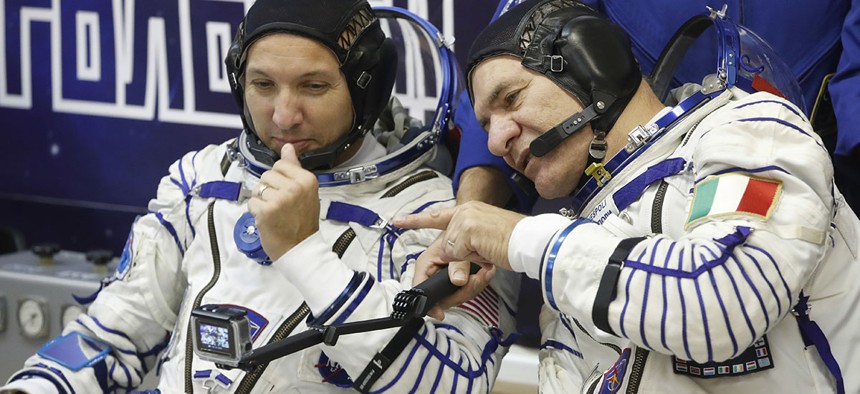The Invention That Turned Our Phones Into Cameras Was Originally Developed by NASA for Space Travel

U.S. astronaut Randy Bresnik , left, and Italian astronaut Paolo Nespoli members of the main crew of the expedition to the International Space Station (ISS), look at a camera prior the launch of Soyuz MS-05 space ship. Dmitri Lovetsky/AP
“Smartphones were not on the radar initially at all."
Next time you take a selfie, thank Eric Fossum. Smartphone cameras, webcams, backup cameras in cars, and even some medical-imaging machines wouldn’t be possible without his 1992 invention, the active pixel sensor. Fossum’s sensor was smaller and far more power-efficient than the competition, which enabled machines to see their surroundings like never before.
The following has been condensed and edited for clarity:
“It was developed under NASA funding in the jet propulsion laboratory in Pasadena, California. We were trying to miniaturize cameras for interplanetary space travel. So that was the driver, and NASA has been slow to adopt it, so it’s just starting to be incorporated into some of their missions. But when we got done, we were like, ‘Wow, not only is this useful for space, but this is pretty useful for here on this planet.’
“Smartphones were not on the radar initially at all. We were thinking about web cameras and we did the first ones from swallowable pill cameras that swim through your intestines and take pictures along the way. And then there were two other niche applications. One of the first early ones was automotive. We worked with a company called Gentex in Michigan, and they were looking at how to put features into cars, looking at automatic dimming headlights that smartly dimmed the beams, and how to build brake sensors automatically, fire up the windshield wipers. The automotive stuff actually happened early on, and someone told me that the killer apps or at least good apps, you don’t find them, they find you.
“People were coming to us and saying, ‘Hey, we think this technology would be good for this.’ Another thing that was also big at the time was dental x-ray sensors. A small sort of company in New York came to us and said, ‘Hey, we think this would be good for dental radiography.’ So we collaborated in that work as well, and that’s become pretty ubiquitous in dental offices; nobody uses film anymore.
“At some point, there seemed to be interest in putting cameras with phones. It first started as a detachable accessory you clip onto your phone, like a little camera you attach. Later they were integrated into the phone itself.
“This is not politically correct, but it’s a true story. We were approached for this camera phone with the application that a company thought that Japanese teenage girls would want to share their shopping experience with other Japanese teenage girls. Having it built into the camera would be really convenient for that. And that was really the initial application for this technology. I think it was just to take a picture of shoes or jewelry or a dress or something like that and to share it.”
This interview is an extended version of a piece featured in Quartz’s new book The Objects that Power the Global Economy.





